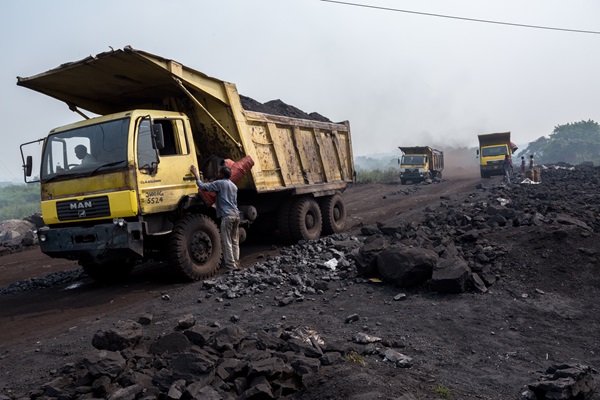.png)

Dev Chandrasekhar advises corporates on big picture narratives relating to strategy, markets, and policy.
May 10, 2025 at 6:46 AM IST
Coal India Ltd, the state-owned mining behemoth, appears to be stuck in another era even as its core product faces an increasingly uncertain future.
The recently-announced 2024-25 results show Coal India in a position of steady strength. Sales were ₹1.4 trillion and profit after tax at ₹353 billion, supporting a final dividend of ₹5.15 per share after an interim payout of ₹15.75.
Yet, beneath these steady numbers, the company faces a trio of significant challenges that could reshape its future.
First, India's accelerating energy transition towards renewables directly reduces long-term coal demand as clean energy sources displace thermal power. This transition is gaining momentum through falling renewable costs, stronger climate commitments, and supportive government policies.
Second, captive coal production has emerged as a disruptor to Coal India’s once-unassailable position. This segment has expanded dramatically from just 9% of India's total coal production in 2019-20 to 15% in 2023-24. The government's target to further increase this to 20% by 2030 signals continued policy support for reducing dependence on Coal India. This shift, unthinkable just a few years ago, signals a new era of competition.
Third, global thermal coal prices have collapsed from peaks of about $445 per tonne in 2023 to nearly $100 currently. This price erosion creates a vice-like squeeze on the company’s fundamental business model, which requires high volume sales and price stability to maintain sales. As prices fall, Coal India must sell even more coal just to stand financially, precisely when it is losing market share to captive producers.
Still, Coal India is not without options. The company’s scale--it held nearly 75% market share in 2023-24--and its extensive mining and logistics network provide a strong foundation. With cash reserves of ₹112 billion as of March 31, it has the heft to invest in its transformation while continuing to deliver attractive dividends.
The diversification plan features the newly-formed Coal Gas India Ltd, a 51:49 joint venture between Coal India and GAIL India, created to set up a coal-to-synthetic natural gas plant in West Bengal. This plant will use surface coal gasification technology and is designed to produce 80,000 Nm³ of synthetic natural gas per hour, with an annual output target of 633.6 million Nm³. Coal India will supply the required 1.9 million tonnes of coal for this facility, which aims to reduce reliance on imported natural gas and support India’s energy security and sustainability goals.
The blueprint also includes agreements for a 500 MW solar project and a 2×800 MW ultra-supercritical thermal power plant in partnership with Damodar Valley Corporation, with a total announced capital expenditure of ₹165 billion. These projects highlight a clear intent to expand into power generation.
Additionally, Coal India has made its first entry into the critical minerals sector by winning the bid for the Khattali Chotti graphite block in Madhya Pradesh. This nearly 600-hectare block, with a fixed carbon content ranging from 1.99% to 6.50%, positions Coal India to play a significant role in domestic graphite production-a key material for batteries and the green energy transition-at a time when India imports about 69% of its graphite needs. This move marks another important step in Coal India’s strategy to diversify beyond coal and tap into new growth areas
The diversification narrative isn't uniformly convincing, though.
Coal India’s initiatives remain in early stages, existing primarily as statements of intent rather than operational ventures with substantial revenue contribution.
For example, the Khattali Chotti graphite block remains rudimentary, with a one year timeline for grant of the composite licence and three years for execution of the mining lease deed. This means Coal India won't begin actual production until at least four years after being declared the preferred bidder.
The company hasn't yet developed or announced comprehensive plans for downstream processing, value addition, or integration into broader battery supply chains. No evidence exists either of a co-ordinated strategy for multiple assets across different mineral categories such as lithium, cobalt, and rare earths.
Coal India’s historically slow execution of non-core projects is another reason for scepticism.
In 2020, Coal India announced plans for several solar projects by March 2024, yet the 50 MW solar power plant at Nigahi was commissioned only in November 2024, significantly behind schedule.
Previous partnerships, including a joint venture with NLC India Ltd for 3 GW of solar power generation announced in 2020, have moved at a glacial pace with limited operational assets to show after several years.
Another concern is asset utilisation efficiency.
The company has consistently missed production targets, with 2024-25 at 781 million tonnes falling significantly short of the 838 million tonnes target. Subsidiary performance varied widely, with SECL showing an 18.7% shortfall from its targeted production.
This chronic under-utilisation of existing assets raises questions about Coal India’s ability to execute more complex initiatives in unfamiliar domains.
Analysts are split on Coal India's future. Those recommending the stock highlight its strong dividend yield, dominant market position, and substantial cash reserves, arguing that coal will remain central to India’s energy mix for years to come. Critics, however, point to the slow pace of diversification and continued focus on traditional operations, suggesting that more decisive action is needed to secure long-term relevance.
With a significant cash position and dominant market share, the company has breathing room—but the clock is ticking. The question isn't whether coal will remain relevant in India's energy mix, but whether Coal India can transform itself beyond being merely a fossil fuel cash cow before disruption reshapes the market.




